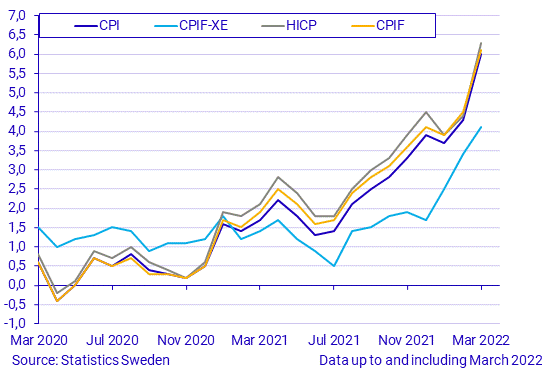Consumer Price Index (CPI), March 2022
Inflation rate was 6.1 percent in March 2022
Statistical news from Statistics Sweden 2022-04-14 8.00
The CPIF (Consumer Price Index with fixed interest rate) 12-month inflation rate was 6.1 percent in March 2022, up from 4.5 percent in February. On a monthly basis, the inflation rate according to the CPIF rose by 1.7 percent from February to March.
“The inflation rate rose sharply because of a general and broad price increase. Prices on food and non-alcoholic beverages rose, but mainly it was rising electricity and fuel prices that had a major impact," says Caroline Neander, statistician at Statistics Sweden.
In brief
| Index Numbers |
Monthly changes, percent |
Annual changes, percent |
|
|---|---|---|---|
| CPI (1980=100) | 359.80 | 1.8 | 6.0 |
| CPIF (1987=100) | 235.98 | 1.7 | 6.1 |
| CPIF-XE (1987=100) | 218.21 | 1.0 | 4.1 |
- The highest inflation rate according to the CPIF since December 1991
- Prices on electricity and fuel sharply increased
- There were many price increases on food, where dairy products affected the most
- Restaurant visits, furniture and vehicle purchases contributed to the high inflation rate
- The inflation rate according to CPIF excluding energy increased from 3.4 percent in February to 4.1 percent in March
Sharply rising energy prices
The CPIF rose by 1.7 percent from February to March. In the corresponding period a year ago, the CPIF increased by 0.2 percent.
The month-on-month change in March was mainly affected by higher prices on electricity and fuel, which together contributed 0.8 percentage points to the month-on-month change.
There was a general and widespread price increases of various goods and services during March. Food prices increased, where the prices of dairy products had a particular impact.
Restaurant visits, furnishings, household equipment and routine maintenance of the house also recorded rising prices. Similarly, the prices of various goods and services increased. There were also seasonal trends for March with rising prices for clothing and shoes while prices of books fell.
The table below shows changes on a monthly basis and contributions to the CPIF based on the goods and services that had the greatest impact on the CPIF in March 2022. The results are presented by COICOP category. COICOP refers to the United Nations classification of household consumption expenditure.
| Category (Coicop) | Monthly changes, percent |
Contribution to CPIF Monthly change, percentage points |
|---|---|---|
| Food (01.1) | 2.4 | 0.3 |
| Clothing and footwear (03) | 3.1 | 0.1 |
| Electricity (04.5.1) | 12.2 | 0.5 |
| Furnishings and household equipment (05) | 1.6 | 0.1 |
| Fuel (07.2.2) | 12.5 | 0.4 |
| Books (09.5.1) | ‑15.8 | ‑0.1 |
| Restaurants (11.1) | 1.5 | 0.1 |
| Miscellaneous goods and services (12) | 0.7 | 0.1 |

Seasonal patterns and temporary price changes
Price changes on goods and services may be seasonal or temporary. The figure above shows the monthly changes this year and in the two most recent years for the goods and services with the largest impact on the CPIF monthly change.
In recent years in March, the fuel prices have both increased and decreased. In March 2022, the price increase was significantly larger than the corresponding period last year. Two years ago, prices fell.
Electricity prices increased in March 2022, unlike the same time in the last year and two years ago when electricity prices fell.
Prices on furnishings, household equipment and routine maintenance of the house rose slightly more in March this year than in March last year. In contrast to March 2020, when prices fell.
Clothing and footwear had a slightly lower price increase in March this year than in the corresponding period in the last two years. While food prices had a more positive increase this year than they had last year and the year before.
Due to the book sale that usually starts at the end of February, and lasts some way into March, the prices of books fell, which is seasonally normal.
Contributions to the inflation rate in March
The inflation rate according to the CPIF, that is, the change in the CPIF over the past 12-month period, was 6.1 percent in February 2022, up from 4,5 percent in February.
The inflation rate was mainly affected by higher energy prices, which contributed by 2.2 percentage points. Additional contributing factors were higher prices for food and non-alcoholic beverages.
There were Increased housing costs and costs of owning the home which includes value of the service. Restaurant visits and hotels became more expensive, as did recreation and culture. Car prices rose and miscellaneous goods and services also rose.
The inflation rate according to the CPIF excluding energy was 4.1 percent in February, up from 3.4 percent in January.
| Category (Coicop) | Yearly change, percent |
Contribution yearly change CPIF percentage points |
|---|---|---|
| Food and non-alcoholic beverages (01) | 5.8 | 0.8 |
| Milk, cheese and eggs (01.1.4) | 6.8 | 0.1 |
| Electricity (04.5.1) | 34.0 | 1.1 |
| Rented and housing co-operative dwellings: rent incl. heating (04.S) | 1.8 | 0.2 |
| Costs of home ownership (04.x) | 7.2 | 0.4 |
| Furnishings and household equipment (05) | 8.1 | 0.6 |
| Motor cars (07.1.1) | 5.6 | 0.3 |
| Fuel (07.2.2) | 46.8 | 1.1 |
| Recreation and culture (09) | 2.9 | 0.4 |
| Restaurants and hotels (11) | 6.0 | 0.4 |
| Miscellaneous goods and services (12) | 3.0 | 0.2 |
Other measures of inflation
Statistics Sweden calculates different inflation measures for different purposes. The CPIF is the Riksbank’s target variable, while the CPI is the measure used for purposes of compensation.

Definitions and explanations
The CPIF shows the same price trend as the CPI, but without the direct effects of a changed monetary policy. The CPIF is the Riksbank’s target variable for the inflation target.
The CPIF excluding energy (CPIF-XE) and the CPIF with constant tax (CPIF-CT) are two other measures of inflation produced by Statistics Sweden on behalf of the Riksbank. In the CPIF-XE, energy products are excluded from the CPIF, while in the CPIF-CT the taxes and subsidies associated with the products in the CPIF are kept constant.
The HICP (Harmonised Index of Consumer Prices) is produced by all EU Member States. This measure has a somewhat smaller coverage than the CPI and the CPIF, mainly because parts of households’ housing costs are omitted.
Next publishing will be
2022-05-12 at 8:00.
Statistical Database
More information is available in the Statistical Database
Feel free to use the facts from this statistical news but remember to state Source: Statistics Sweden.
